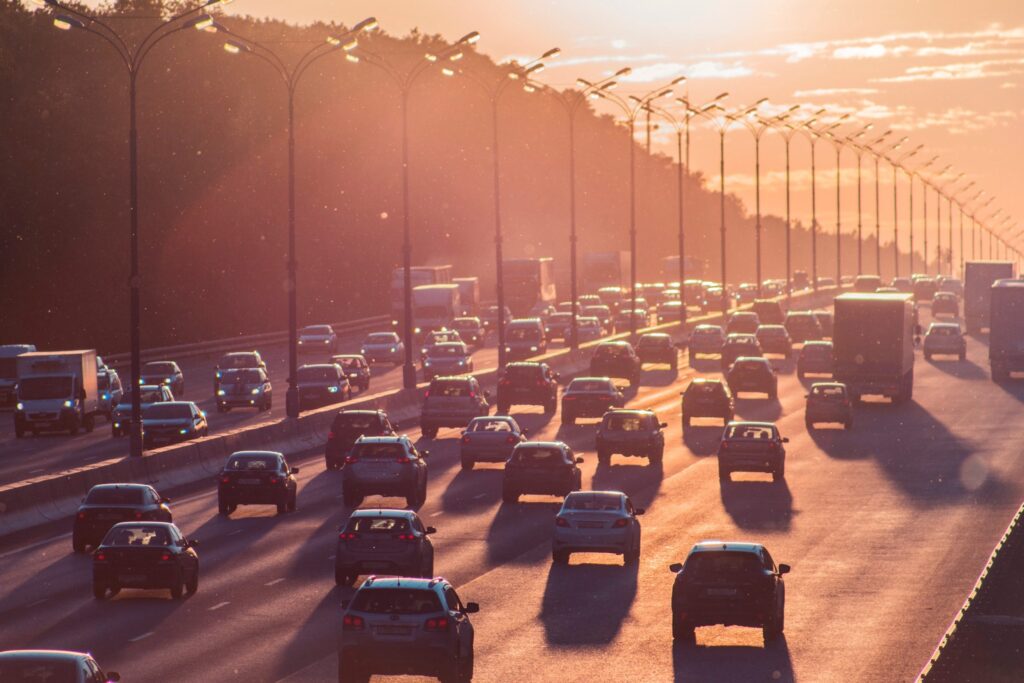May is Clean Air Month – we are highlighting different kinds of air pollution during Clean Air month.
What is NO2/NOx?
Nitrogen dioxide, and other nitrogen oxides, form when we burn fuel. Nitrogen oxides include nitrogen oxide (NO, also called nitric oxide), nitrogen dioxide (NO2), nitrous oxide (N2O), and other variants of nitrogen combined with several oxygen atoms. They are similar in their health effects so we often use NOx to refer to all the nitrogen oxides.
Air is 78% nitrogen gas. A nitrogen gas molecule is two atoms of nitrogen bonded together (N2).
At everyday temperatures, nitrogen stays by itself, as nitrogen gas (N2). When we burn things, the high heat allows nitrogen to bond with oxygen, and we get mostly NO2, some NO, and sometimes a few other NOx.
Because we burn so much fossil fuel, fossil fuels are the primary source of nitrogen oxides (NOx) in the air. It comes from transportation (cars, trucks, diesel engines), power plants (coal or gas), industrial boilers (coal and gas), off road vehicles (construction, trains), and even inside your house when you have a gas stove, gas fireplace, or gas furnace, and also if you have a kerosene space heater. Lightning and wildfires can also create nitrogen oxides (NOx).
Are Nitrogen Oxides (NOx) a Problem?
Nitrogen oxides can damage our health, and they can also form acid rain that damages trees and animals.
Nitrogen oxides also have chemical reactions with other molecules in the air that create ozone and particulate matter. Both ozone and particulate matter also damage our health.
What are the Health Problems That Come From NOx?
Nitrogen oxides (NOx) are an irritant to your lungs and airways. They cause inflammation, cough and wheezing, poor lung function, and asthma attacks. They also can cause asthma in children, and damage lung growth in children and teens. They’re also linked to heart disease in adults, and lower birth weight in babies. A recent study found that nitrogen dioxide causes 1.6% of all deaths in the U.S.
During the COVID pandemic, several studies found that cities around the world that had higher levels of nitrogen oxides (NOx) had higher rates of infection and higher rates of death from COVID. Nitrogen oxides have also been linked to higher risk of other infections.
Who is Most At Risk From NOx?
All children are vulnerable to nitrogen oxides (NOx), because they can cause asthma and damage children and teens’ lung growth. Children with asthma are at even more risk.
Older adults are also more vulnerable, and also any adult with lung conditions such as asthma, emphysema, or COPD.
Because of our country’s history of redlining and environmental racism, highways and power plants are more often located in communities of color. This creates unequal exposure for nitrogen oxides and other air pollution, and causes more health problems for those communities.
What Can We Do About NOx?
The best thing we can do about NOx, is to stop burning fossil fuels which are the main source of NOX. This means clean, renewable power such as solar, wind, or geothermal. Solar and wind are now less expensive than both coal and gas.
The second best thing we can do is to reduce the amount of Nitrogen oxides (NOx) produced from gasoline vehicles and power plants. It could be something such as a catalytic converter on a car, or a more complicated converter on a power plant. Every state has a state implementation plan that has plans for that state to make less nitrogen oxides (NOx) from both vehicles and power plants.
Because gas stoves and appliances can make nitrogen oxides (NOx) inside your home, the best thing is when it’s time to replace your stove or furnace, to get an electric stove or heat pump for your house. If you can afford it, replace them sooner. The second best is to maintain stoves and furnaces, and make sure there is good ventilation that takes the exhaust from the stove or furnace outside. This could be a flu for the furnace (required by all building codes), or an exhaust fan for your kitchen (not required but a really good idea). If you don’t own your home and it doesn’t have a kitchen exhaust fan, the next best thing is to open some windows when you cook. This will let the nitrogen oxides (NOx) out and bring in fresh air.
How Can We Do It?
It takes both individual action and government policy to make our air cleaner.
If you are able, you can buy an EV car, take transit (subways or buses), and replace your gas stove or furnace. Anything you do to reduce electricity use will mean your power company is burning less coal or gas and therefore making less nitrogen oxides.
Some things will need government policies and support, at all levels of government: city, state, and federal. Policies can include incentives or grants for energy conservation, electric vehicles of all kinds, electric vehicle charging stations, and clean power. We need grants and subsidies for lower wealth and historically marginalized communities, to reduce energy burden and health disparities. EPA can set stronger air pollution standards. We can support solar, wind, and geothermal, and stop subsidizing fossil fuels.
And remember, because nitrogen oxides come from burning fossil fuels, anything we do to reduce nitrogen oxides will also help fight climate change.
Do what you can as an individual, and use this link to advocate with your elected officials at all levels and let them know you want healthy air. It keeps us all healthier: Healthy Air is Health Care.
Other reading: Basic information from EPA
American Lung Association
Article in Phys.Org
05/10/2021





